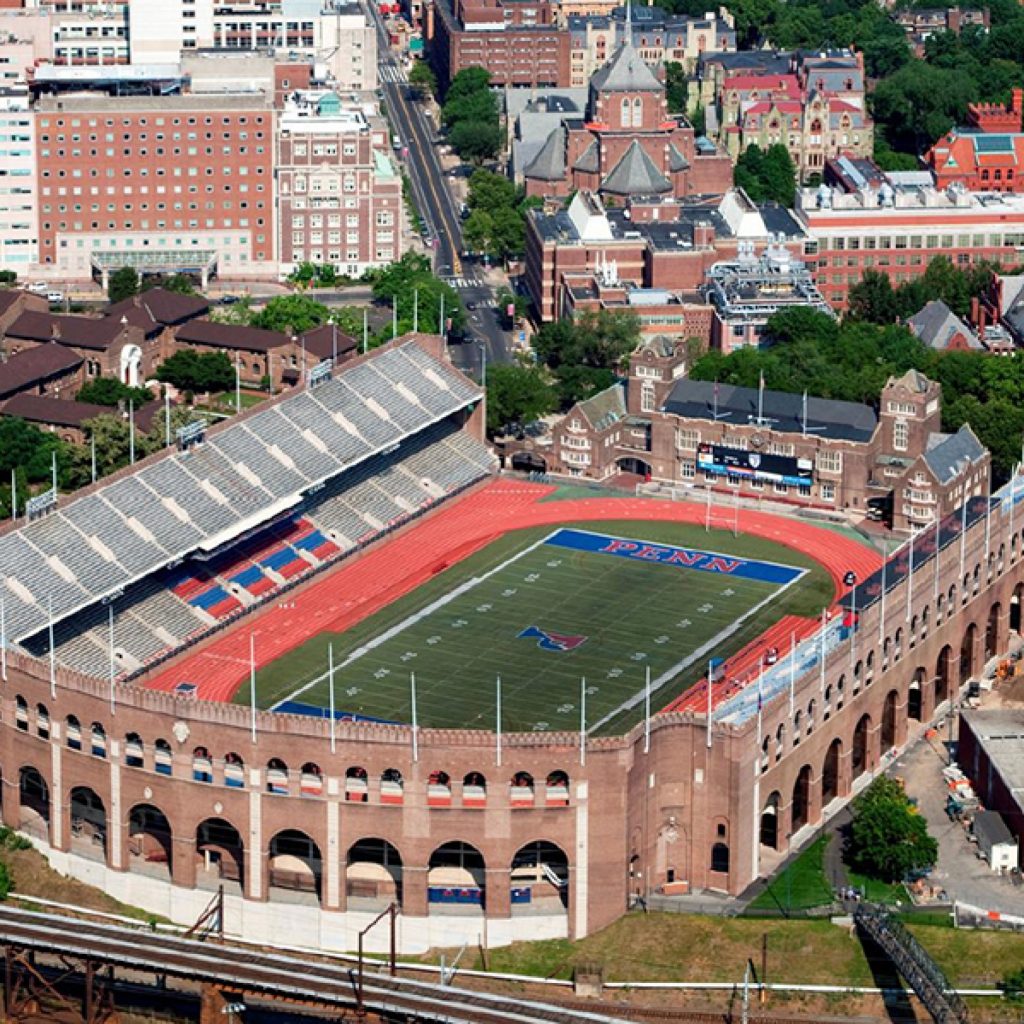I tried. I really did. I said I was going to stick to writing stories about racing’s history and not devote my time to bashing NASCAR.
A modern communicator would deny having said that, shift the blame to somebody else, and change the conversation completely. I prefer to say, “I lied.”
I didn’t write a word after Steve Phelps was named NASCAR’s “first commissioner,” and NASCAR chose to ignore the folks who held that title in the 1940s, ‘50s, and ‘60s. But then Steve O’Donnell, who has succeeded Phelps as NASCAR’s president, started talking about the possibility of a NASCAR race at Franklin Field in Philadelphia.

It could happen, or it could be like Bill France’s speedway on Staten Island in New York: whoops! What bugs me is the way this was all presented. Read on if you want to hear my rant; otherwise, I’m sure there’s something on other media or in the refrigerator that will occupy your time just fine.
Let’s start with the politician-speak that lit the biggest fire. I will be quoting here from a story by Matt Connolly for PennLive, a noble effort to turn the “legacy media” Harrisburg Patriot News (and other papers, at least at one time) into a multimedia news outlet that would survive in what may eventually be the post-newspaper world. Connolly was covering O’Donnell speaking to the Associated Press Sports Editors.
Connolly quotes O’Donnell mentioning the Chicago Street Race and the L.A. Coliseum races.
“The success of the street race has led to NASCAR exploring other unique events, including a potential race at Franklin Field,” Connolly writes.
“According to O’Donnell,” he continues, “NASCAR has a passionate group of fans in the Northeast. If NASCAR does indeed hold a race in Philadelphia, he has no doubt that fans would get behind it.”
“’If you look at Pennsylvania, New York, New Jersey, and you look at short track racing, there’s a huge, hardcore short track market with a lot of local fans who love racing in general,’ O’Donnell said.
“It’s got that built in and there’s the (Pocono Raceway) infield experience. Those areas are still a bit underserved. You look at Pocono, Dover and New Hampshire. The northeast is a huge fan base for us.”
As a former “legacy media” writer and editor, let me say that I have no idea whether O’Donnell was quoted correctly or in property context, but I suspect this is a fair job of reporting what he said.
That being the case . . . HOW IN THE WORLD CAN YOU TALK ABOUT THE “UNDERSERVED” FANS AND CITE POCONO, DOVER AND NEW HAMPSHIRE, WHEN NASCAR HAS TAKEN A RACE DATE AWAY FROM EACH OF THOSE TRACKS? If the fans are underserved, put another race at one of the tracks that used to run two events a year.
While we’re talking like a politician, how about this: “’We’re in Chicagoland and we’ve got an oval that’s an hour outside of Chicago. We’re doing great there. We raced on the streets of Chicago and all of a sudden, wow, NASCAR, we brought it to the people,’ O’Donnell said.”
That’s one place where I have to question the accuracy of the quote. I can’t believe O’Donnell mentioned Chicagoland Speedway (the oval) and claimed success, when NASCAR doesn’t run there at all, anymore.

Furthermore, the “innovative” racing in the L.A. Coliseum lasted two years, and after the second year reportedly saw a drop in attendance, there was no third year. Earlier this year, there was talk about the 2025 Chicago Street Race being the last for that innovation. None of the achievements being claimed in this story stand up to what the quotes would have you believe.
I know. When you’re promoting something, you don’t talk about past failures (or even successes with limitations). You try to make it all sound as positive as possible.
And NASCAR has been doing that since Big Bill France brought his road show to Detroit in 1951 to show off to the car company execs. They returned the next year and haven’t been back since 1952. There are plenty of other, similar experiments spread through the NASCAR history book.
The more things change. . . .
What seems not to have changed is that NASCAR feels the need to be “big time,” and that means the cities. Here’s how O’Donnell put it:
“’When you look at opportunities, one of the places we looked around with the Coliseum was in Philly, Franklin Field. It was one of the only ones that we could put a race track inside of . . . Those are the types of things in a city we’re going to look at because the days of just building a rural track are over.”
I guess that’s why we now have two Cup races at Darlington (a rural track NASCAR tried to kill), and Rockingham (a rural track it did kill) has come back and suddenly is a hot commodity, yet the Coliseum is history, and the Chicago Street Race may follow it.
You may criticize me for my attitude here. I readily admit that, unlike the Daytona Beach brass, I don’t need for NASCAR to keep growing. I liked it the way it was when 15,000 fans packed the half-mile dirt track at the Virginia State Fairgrounds back in 1963 to watch Joe Weatherly outduel Junior Johnson to win the Richmond 250 and the princely victor’s purse of $2,400. Virginia alcoholic beverage control agent Worth McMillion finished 10th and got $200. The purse wasn’t enough to pay for engineers on the team roster (or investors), and the sanctioning fee didn’t cover a lot of vice presidents’ salaries. But the race made me a race fan, and I don’t know if that would happen at any of today’s races.
Steve, I hope you find those fans some algorithm says you need to be successful in today’s dollar-dominated world. One of them can have my seat, because I’ll be down at a local short track, having fun and enjoying racing the way I know and love it.
Frank’s Loose Lug Nuts
Maybe NASCAR knows Philly won’t be on the racing schedule forever. Maybe they’ve actually decided that the future is to go to where a Cup race will draw fans as a novelty, then leave when the novelty wears off, and the fans find something else to do. I hold that the Coliseum is a perfect example of that, and in all likelihood, Chicago will end up the same. (I also hold that will happen with Formula One in this country, but that’s another discussion.)
“The more things change, the more they stay the same,” holds true here, too. I’ve been doing some semi-mindless history research lately with a newly available (to me) online resource, and I was looking at Unionville Speedway, a small central Virginia dirt track that operated for most of three seasons, 1952-54. In those days, new tracks were popping up everywhere, as stock car racing made it easier for drivers to get involved and gave fans a car to identify with on the track.
Unionville is pretty much out in the middle of nowhere today, so imagine how things were 73 years ago. Yet the story about its opening race was all positive, and the future looked bright. It only took a couple of years for that to change. The track had to compete with others to get the big names from Richmond or the Baltimore-Washington area to run against the locals, most notably Lionel Johnson, who ran a garage there for years and ran 13 Grand National/Cup races in 1965-66, with a best finish of ninth at Richmond in ’65, when he started next-to-last in a 37 car field and survived to be just eight laps behind the leader at the end. Even with Lionel on the track, the novelty of Unionville Speedway wore off.
A couple of years later, there was a classified ad in the Richmond newspaper offering the place for $6,000, with easy monthly payments available.

The backers of Unionville Speedway probably would be excited about some of NASCAR’s new ideas, too.
(BTW, in answer to “Why were you looking up this place?” I pass the site of the speedway on trips back to visit family in Virginia. Nothing remains, but if I’m by myself, I might open the window to see if I can hear the roar.)
(BTW2, I hope to get back to writing history pieces and plan to have one for this space before long. Hope that doesn’t chase you away.)
Frank Buhrman
Photo Credit (cover): Liberty Bell Center


